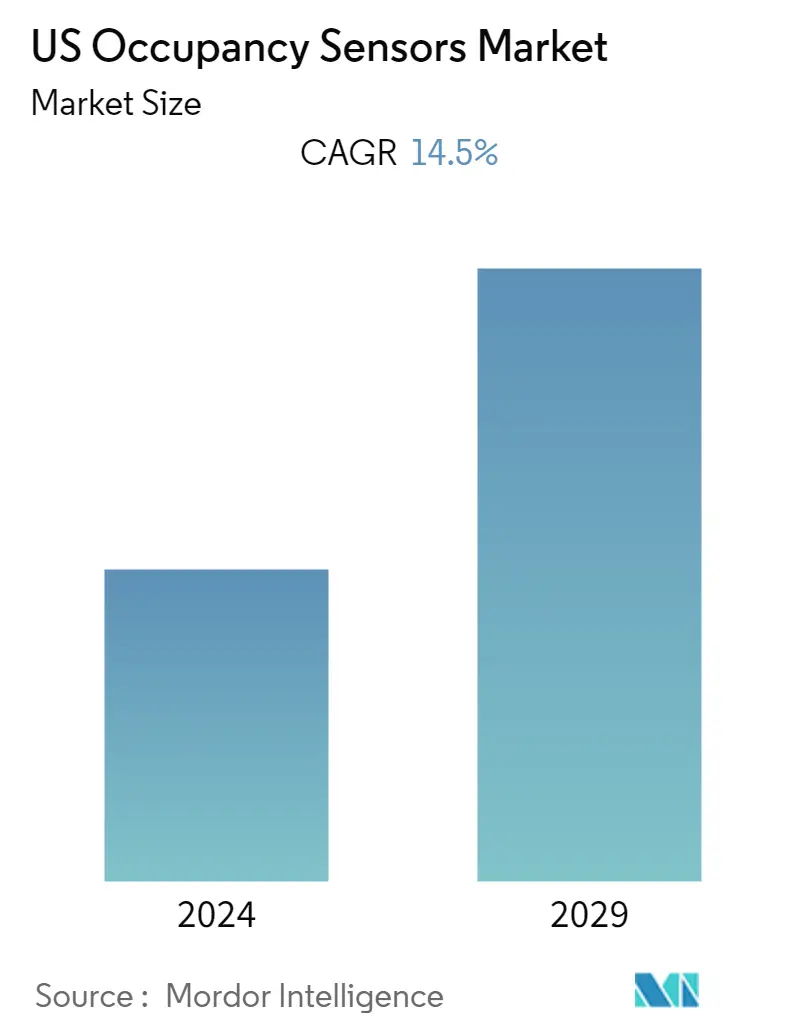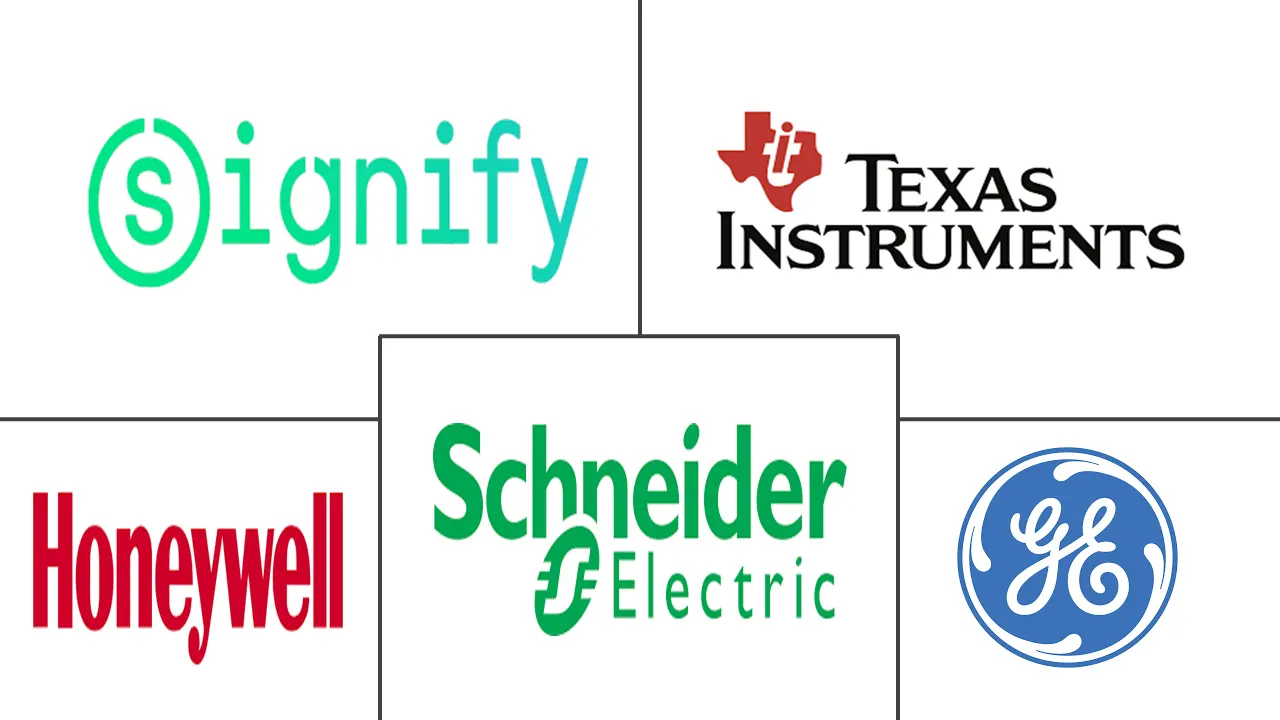Market Size of US Occupancy Sensors Industry

| Study Period | 2019 - 2029 |
| Base Year For Estimation | 2023 |
| Forecast Data Period | 2024 - 2029 |
| Historical Data Period | 2019 - 2022 |
| CAGR | 14.50 % |
| Market Concentration | Medium |
Major Players
*Disclaimer: Major Players sorted in no particular order |
US Occupancy Sensors Market Analysis
The United States Occupancy Sensors Market is expected to register a CAGR of 14.5% during the forecast period, 2021-2026. Smart building technology and occupancy sensors can provide real-time data, allowing to make better decisions for building management under the new guidelines of COVID-19. Whether saving space or improving hygiene, occupancy IoT sensors can help mobilize and optimize the back-to-work process.
- One of the major driving factors for the expansion of occupancy sensors is the trend of urbanization. There is a growing demand for energy efficiency across homes and offices. According to the United Nations Department of Economic and Social Affairs, 68% of the population will be living in cities by 2050, which will augment sustainable energy use.
- The rising demand for energy-efficient devices is expected to drive the country. Occupancy sensors play a vital role in reducing energy consumption. This is achieved through the sensors, which shut down devices and other equipment based on occupancy. These sensors help reduce light pollution and can be used for indoor and outdoor spaces.
- The demand for passive infrared is expected to continue in the country due to the low cost, demand for energy-efficient devices, and less power requirement. It has a range of applications, such as lighting, spectrometers, gas, and fire detection systems. Some of the significant benefits of passive infrared sensors are accurate movement detection, reliable triggering, and cost-efficiency. Vending machine designers, for instance, are now incorporating PIR sensors into their products so that their displays only light up when someone is standing in front of the unit or maybe waving their hand in front of a panel, which saves on operating costs.
- Partnerships and entry by global players into the country are also expected to shape the market landscape in the future. Recently, Austria-based Loxone entered the US market with a smart home automation control offering that features more than 150 SKUs of products, including occupancy sensors, temperature and humidity sensors.
US Occupancy Sensors Industry Segmentation
An occupancy sensor is used to save energy, comply with building codes, and provide automatic control and various other such applications. One of the most-used technologies among the occupancy sensors is the passive infrared, which detects occupancy within a specific field and activates lighting, and is extremely useful in small spaces. Moreover, the advent of advanced occupancy sensors, such as micro-phonics, intelligent occupancy sensors, image processing occupancy sensors, and the new vision-based intelligent occupancy sensor, for HVAC systems is fueling the growth of the occupancy sensor market.
| By Network Type | |
| Wired | |
| Wireless |
| By Technology | |
| Ultrasonic | |
| Passive Infrared | |
| Microwave |
| By Application | |
| Lighting Control | |
| HVAC | |
| Security and Surveillance |
| By Building Type | |
| Residential | |
| Commercial |
US Occupancy Sensors Market Size Summary
The United States Occupancy Sensors Market is experiencing significant growth, driven by the increasing demand for energy-efficient solutions and the adoption of smart building technologies. These sensors play a crucial role in optimizing energy consumption by automating the control of lighting and HVAC systems based on occupancy, thereby reducing energy waste and enhancing sustainability. The trend of urbanization and the shift towards smart city developments further propel the market, as cities seek to improve energy efficiency and reduce carbon footprints. The integration of occupancy sensors with IoT technologies allows for real-time data collection and analysis, enabling better space management and decision-making in response to evolving workplace dynamics, especially in the wake of the COVID-19 pandemic.
The market is characterized by a moderate level of competition, with key players focusing on innovation, strategic partnerships, and product launches to maintain their competitive edge. The demand for passive infrared sensors remains strong due to their cost-effectiveness and energy-saving capabilities. Additionally, advancements in sensor technology, such as image processing and intelligent occupancy sensors, are expected to drive further market expansion. The growing interest in smart home automation and the increasing incorporation of occupancy sensors in various applications, from vending machines to HVAC systems, highlight the diverse opportunities within the market. As companies continue to invest in research and development, the market is poised for continued growth, supported by regulatory initiatives and the ongoing transition towards more sustainable and intelligent building solutions.
US Occupancy Sensors Market Size - Table of Contents
-
1. MARKET INSIGHTS
-
1.1 Market Overview
-
1.2 Industry Attractiveness - Porter's Five Forces Analysis
-
1.2.1 Bargaining Power of Suppliers
-
1.2.2 Bargaining Power of Consumers
-
1.2.3 Threat of New Entrants
-
1.2.4 Threat of Substitutes
-
1.2.5 Intensity of Competitive Rivalry
-
-
1.3 Impact of COVID-19 on the Market
-
-
2. MARKET SEGMENTATION
-
2.1 By Network Type
-
2.1.1 Wired
-
2.1.2 Wireless
-
-
2.2 By Technology
-
2.2.1 Ultrasonic
-
2.2.2 Passive Infrared
-
2.2.3 Microwave
-
-
2.3 By Application
-
2.3.1 Lighting Control
-
2.3.2 HVAC
-
2.3.3 Security and Surveillance
-
-
2.4 By Building Type
-
2.4.1 Residential
-
2.4.2 Commercial
-
-
US Occupancy Sensors Market Size FAQs
What is the current US Occupancy Sensors Market size?
The US Occupancy Sensors Market is projected to register a CAGR of 14.5% during the forecast period (2024-2029)
Who are the key players in US Occupancy Sensors Market?
Signify Holding BV, Texas Instruments Inc, Schneider Electric SE, Honeywell Inc and General Electric Co are the major companies operating in the US Occupancy Sensors Market.

